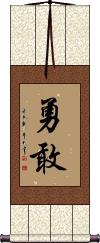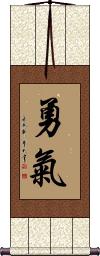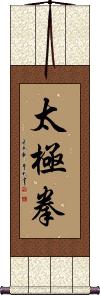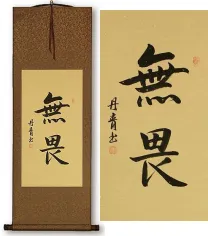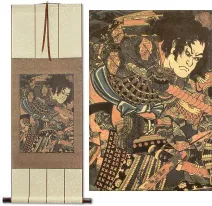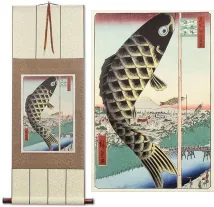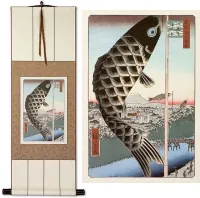Many custom options...
And formats...

The name No Mental in Chinese / Japanese...
Buy a No Mental calligraphy wall scroll here!
Personalize your custom “No Mental” project by clicking the button next to your favorite “No Mental” title below...
Bravery / Courage
Courage in the face of Fear
勇敢 is about courage or bravery in the face of fear.
You do the right thing even when it is hard or scary. When you are courageous, you don't give up. You try new things. You admit mistakes. This kind of courage is the willingness to take action in the face of danger and peril.
勇敢 can also be translated as braveness, valor, heroic, fearless, boldness, prowess, gallantry, audacity, daring, dauntless, and/or courage in Japanese, Chinese, and Korean. This version of bravery/courage can be an adjective or a noun. The first character means bravery and courage by itself. The second character means “daring” by itself. The second character emphasizes the meaning of the first but adds the idea that you are not afraid of taking a dare, and you are not afraid of danger.
勇敢 is more about brave behavior and not so much the mental state of being brave. You'd more likely use this to say, “He fought courageously in the battle,” rather than “He is very courageous.”
Bravery / Courage
Courageous Energy
勇氣 is one of several ways to express bravery and courage in Chinese, Japanese, and Korean.
This version is the most spiritual. This is the essence of bravery from deep within your being. This is the mental state of being brave versus actual brave behavior. You'd more likely use this to say, “He is very courageous,” rather than “He fought courageously in the battle.”
The first character also means bravery or courage when it's seen alone. With the second character added, an element of energy or spirit is added. The second character is the same “chi” or “qi” energy that Kung Fu masters focus on when they strike. For this reason, you could say this means “spirit of courage” or “brave spirit.”
This is certainly a stronger word than just the first character alone.
Beyond bravery or courage, dictionaries also translate this word as valor/valour, nerve, audacity, daring, pluck, plucky, gallantry, guts, gutsy, and boldness.
This is also one of the 8 key concepts of tang soo do.
![]() While the version shown to the left is commonly used in Chinese and Korean Hanja (and ancient Japanese Kanji), please note that the second character is written with slightly fewer strokes in modern Japanese. If you want the modern Japanese version, please click on the character to the right. Both styles would be understood by native Chinese, Japanese, and many (but not all) Korean people. You should make your selection based on the intended audience for your calligraphy artwork. Or pick the single-character form of bravery/courage which is universal.
While the version shown to the left is commonly used in Chinese and Korean Hanja (and ancient Japanese Kanji), please note that the second character is written with slightly fewer strokes in modern Japanese. If you want the modern Japanese version, please click on the character to the right. Both styles would be understood by native Chinese, Japanese, and many (but not all) Korean people. You should make your selection based on the intended audience for your calligraphy artwork. Or pick the single-character form of bravery/courage which is universal.
Tai Chi Chuan / Tai Ji Quan
太極拳 is the famous Taoist meditation and martial art exercise. The direct translation of these characters would be something like “grand ultimate fist,” but that does not quite hit the mark for what this title really means.
An early-morning walk through any city in China near a park or an open area will yield a view of Chinese people practicing this ancient technique.
A typical scene is an old man of no less than 80 years on this earth, with a wispy white beard and perhaps a sword in one hand. He makes slow moves that are impossibly smooth. He is steady-footed and always in balance. For him, time is meaningless and proper form, and technique is far more important than speed.
For the younger generation, faster moves may look impressive and seem smooth to the casual observer. But more discipline and mental strength are needed to create perfectly smooth moves in virtual slow motion.
Note: There are two ways to Romanize these Chinese characters, as seen in the title above. The pronunciation and actual characters are the same in Chinese. If you really used English sounds/words to pronounce this, it would be something like “tie jee chew-on” (make the “chew-on” one flowing syllable).
This in-stock artwork might be what you are looking for, and ships right away...
Gallery Price: $108.00
Your Price: $59.88
Gallery Price: $108.00
Your Price: $59.88
Gallery Price: $300.00
Your Price: $109.88
Gallery Price: $61.00
Your Price: $33.88
Gallery Price: $61.00
Your Price: $33.88
Gallery Price: $61.00
Your Price: $33.88
Gallery Price: $61.00
Your Price: $33.88
Gallery Price: $61.00
Your Price: $33.88
Gallery Price: $108.00
Your Price: $59.88
Gallery Price: $90.00
Your Price: $49.88
Not the results for no mental that you were looking for?
Below are some entries from our dictionary that may match your no mental search...
| Characters If shown, 2nd row is Simp. Chinese |
Pronunciation Romanization |
Simple Dictionary Definition |
心 see styles |
xīn xin1 hsin shin しん |
More info & calligraphy: Heart / Mind / Spirit(1) (See 心・こころ・1) heart; mind; spirit; vitality; inner strength; (2) bottom of one's heart; core (of one's character); nature; (3) (usu. written as 芯) (See 芯・2) centre; center; core; heart; (4) (See 心臓・1) heart (organ); (5) {astron} (See 二十八宿) Chinese "Heart" constellation (one of the 28 mansions); (6) (archaism) (child. language) friend; (given name) Haato hṛd, hṛdaya 汗栗太 (or 汗栗馱); 紀哩馱 the heart, mind, soul; citta 質多 the heart as the seat of thought or intelligence. In both senses the heart is likened to a lotus. There are various definitions, of which the following are six instances: (1) 肉團心 hṛd, the physical heart of sentient or nonsentient living beings, e. g. men, trees, etc. (2) 集起心 citta, the ālayavijñāna, or totality of mind, and the source of all mental activity. (3) 思量心 manas, the thinking and calculating mind; (4) 緣慮心; 了別心; 慮知心; citta; the discriminating mind; (5) 堅實心 the bhūtatathatā mind, or the permanent mind; (6) 積聚精要心 the mind essence of the sutras. |
意 see styles |
yì yi4 i i い |
More info & calligraphy: Idea / Thought / Meaning(1) feelings; thoughts; (2) meaning; (personal name) Kokoro Manas, the sixth of the ṣaḍāyatanas or six means of perception, i.e. sight, hearing, smell, taste, touch, and mind. Manas means "mind (in its widest sense as applied to all the mental powers), intellect, intelligence, understanding, perception, sense, conscience, will". M.W. It is "the intellectual function of consciousness", Keith. In Chinese it connotes thought, idea, intention, meaning, will; but in Buddhist terminology its distinctive meaning is mind, or the faculty of thought. |
狂 see styles |
kuáng kuang2 k`uang kuang kyou / kyo きょう |
More info & calligraphy: Crazy / Mad / Wild(suffix) (1) (some type of) enthusiast; (suffix) (2) someone possessed of a (certain kind of) mental abnormality Deranged, mad, wild. |
身 see styles |
shēn shen1 shen mi み |
More info & calligraphy: Body(1) one's body; one's person; (2) oneself; one's appearance; (3) one's place (in society, etc.); one's position; (4) main part; meat (as opposed to bone, skin, etc.); wood (as opposed to bark); blade (as opposed to its handle); container (as opposed to its lid); (surname) Misaki kāya; tanu; deha. The body; the self.; Two forms of body; there are numerous pairs, e. g. (1) (a) 分段身 The varied forms of the karmic or ordinary mortal body, or being; (b) 變易身 the transformable, or spiritual body. (2) (a) 生身 The earthly body of the Buddha; (b) 化身 hinirmāṇakāya, which may take any form at will. (3) (a) 生身 his earthly body; (b) 法身 his moral and mental nature—a Hīnayāna definition, but Mahāyāna takes his earthly nirmāṇakāya as the 生身 and his dharmakāya or that and his saṃbhogakāya as 法身. (4) 眞應二身 The dharmakāya and nirmāṇakāya. (5) (a) 實相身 The absolute truth, or light, of the Buddha, i. e. the dharmakāya; (b) 爲物身 the functioning or temporal body. (6) (a) 眞身 the dharmakāya and saṃbhogakāya; (b) 化身 the nirmāṇakāya. (7) (a) 常身 his permanent or eternal body; (b) 無常身 his temporal body. (8) (a) 實身 and 化身 idem 二色身. |
修養 修养 see styles |
xiū yǎng xiu1 yang3 hsiu yang shuuyou / shuyo しゅうよう |
More info & calligraphy: Self-Improvement(n,vs,vi) self-improvement; (mental) training; self-discipline; cultivation cultivating moral character |
啟發 启发 see styles |
qǐ fā qi3 fa1 ch`i fa chi fa |
More info & calligraphy: To inspire or enlighten |
心印 see styles |
xīn yìn xin1 yin4 hsin yin shinnin |
More info & calligraphy: Appreciation of Truth by Meditation |
心眼 see styles |
xīn yǎn xin1 yan3 hsin yen shingan しんがん |
More info & calligraphy: Mind’s Eyethe mind's eye The eye of the mind, mental vision. |
愛心 爱心 see styles |
ài xīn ai4 xin1 ai hsin aishin あいしん |
More info & calligraphy: Loving Heart / Compassion(obsolete) love; affection; (female given name) Rabu A loving heart; a mind full of desire; a mind dominated by desire. |
智慧 see styles |
zhì huì zhi4 hui4 chih hui tomoe ともえ |
More info & calligraphy: Wisdom(1) wisdom; wit; sagacity; sense; intelligence; (2) (Buddhist term) prajna (insight leading to enlightenment); (female given name) Tomoe jñāna as 智 knowledge and prajñā as 慧 discernment, i.e. knowledge of things and realization of truth; in general knowledge and wisdom; but sometimes implying mental and moral wisdom. |
瑜伽 see styles |
yú jiā yu2 jia1 yü chia yuga ゆが |
More info & calligraphy: Yoga{Buddh} (See ヨーガ) yoga; (surname) Yuga yoga; also 瑜誐; 遊迦; a yoke, yoking, union, especially an ecstatic union of the individual soul with a divine being, or spirit, also of the individual soul with the universal soul. The method requires the mutual response or relation of 境, 行, 理, 果 and 機; i.e. (1) state, or environment, referred to mind; (2) action, or mode of practice; (3) right principle; (4) results in enlightenment; (5) motivity, i.e. practical application in saving others. Also the mutual relation of hand, mouth, and mind referring to manifestation, incantation, and mental operation; these are known as 瑜伽三密, the three esoteric (means) of Yoga. The older practice of meditation as a means of obtaining spiritual or magical power was distorted in Tantrism to exorcism, sorcery, and juggling in general. |
身心 see styles |
shēn xīn shen1 xin1 shen hsin shinshin しんじん |
More info & calligraphy: Body and Mind(noun - becomes adjective with の) mind and body Body and mind, the direct fruit of the previous life. The body is rūpa, the first skandha; mind embraces the other four, consciousness, perception, action, and knowledge; v. 五蘊. |
魂魄 see styles |
hún pò hun2 po4 hun p`o hun po konpaku こんぱく |
More info & calligraphy: Ghost / Soul / Spiritsoul; spirit; ghost Animus and anima; the spiritual nature or mind, and the animal soul; the two are defined as mind and body or mental and physical, the invisible soul inhabiting the visible body, the former being celestial, the latter terrestrial. |
精神性 see styles |
jīng shén xìng jing1 shen2 xing4 ching shen hsing seishinsei / seshinse せいしんせい |
More info & calligraphy: Spiritualityspirituality; spiritual nature |
精神統一 see styles |
seishintouitsu / seshintoitsu せいしんとういつ |
More info & calligraphy: Concentration |
メンタルタフネス see styles |
mentarutafunesu メンタルタフネス |
More info & calligraphy: Mental Toughness |
化 see styles |
huà hua4 hua ka か |
to make into; to change into; -ization; to ... -ize; to transform; abbr. for 化學|化学[hua4 xue2] (suffix) (after a noun) (See 機械化,映画化) change to ...; becoming ...; making into ...; -ization; -ification; (personal name) Fua To transform, metamorphose: (1) conversion by instruction, salvation into Buddhism; (2) magic powers 通力 of transformation, of which there are said to be fourteen mental and eight formal kinds. It also has the meaning of immediate appearance out of the void, or creation 無而忽起; and of giving alms, spending, digesting, melting, etc. |
受 see styles |
shòu shou4 shou ju じゅ |
to receive; to accept; to suffer; subjected to; to bear; to stand; pleasant; (passive marker); (LGBT) bottom {Buddh} (See 五蘊,十二因縁) vedana (sensation); (place-name) Uke To receive, be, bear; intp. of vedana, 'perception,' 'knowledge obtained by the senses, feeling, sensation.' M. W. It is defined as mental reaction to the object, but in general it means receptivity, or sensation; the two forms of sensation of physical and mental objects are indicated. It is one of the five skandhas; as one of the twelve nidānas it indicates the incipient stage of sensation in the embryo. |
垢 see styles |
gòu gou4 kou ku く |
dirt; disgrace {Buddh} (See 煩悩・2) klesha (polluting thoughts such as greed, hatred and delusion, which result in suffering); (personal name) Yoshimi mala. Dust, impurity, dregs; moral impurity; mental impurity. Whatever misleads or deludes the mind; illusion; defilement; the six forms are vexation, malevolence, hatred, flattery, wild talk, pride; the seven are desire, false views, doubt, presumption, arrogance, inertia, and meanness. |
境 see styles |
jìng jing4 ching sakae さかえ |
border; place; condition; boundary; circumstances; territory (1) border; boundary; (2) turning point; watershed; (3) area; region; spot; space; environment; (4) psychological state; mental state; (1) border; boundary; (2) area; region; spot; space; environment; (3) psychological state; mental state; (4) (Buddhist term) cognitive object; something perceptible by the sense organs or mind; (surname) Sakae viṣaya; artha; gocara. A region, territory, environment, surroundings, area, field, sphere, e.g. the sphere of mind, the sphere of form for the eye, of sound for the ear, etc.; any objective mental projection regarded as reality. |
思 see styles |
sī si1 ssu shiyou / shiyo しよう |
to think; to consider (given name) Shiyou cint- 指底. Think, thought; turn the attention to; intp. by 心所法 mental action or contents, mentality, intellection. |
惑 see styles |
huò huo4 huo waku わく |
to confuse; to be puzzled {Buddh} (See 煩悩・ぼんのう・2) klesha; (given name) Waku moha. Illusion, delusion, doubt, unbelief; it is also used for kleśa, passion, temptation, distress, care, trouble. |
數 数 see styles |
shuò shuo4 shuo kazusaki かずさき |
(literary) frequently; repeatedly (surname) Kazusaki To number, count, enumerate, figure out, calculate, reason, reprimand; numbers, an account, fate, destiny; flurried. It is also used for 智 knowledge, and for mental content or conditions as in 心數. |
緒 绪 see styles |
xù xu4 hsü sho; cho しょ; ちょ |
beginnings; clues; mental state; thread beginning; inception; (personal name) Osachi |
苦 see styles |
kǔ ku3 k`u ku ku く |
bitter; hardship; pain; to suffer; to bring suffering to; painstakingly (1) pain; anguish; suffering; distress; anxiety; worry; trouble; difficulty; hardship; (2) {Buddh} (See 八苦) duhkha (suffering) duḥkha, 豆佉 bitterness; unhappiness, suffering, pain, distress, misery; difficulty. There are lists of two, three, four, five, eight, and ten categories; the two are internal, i. e. physical and mental, and external, i. e. attacks from without. The four are birth, growing old, illness, and death. The eight are these four along with the pain of parting from the loved, of meeting with the hated, of failure in one's aims, and that caused by the five skandhas; cf. 四諦. |
蘊 蕴 see styles |
yùn yun4 yün osamu おさむ |
to accumulate; to hold in store; to contain; to gather together; to collect; depth; inner strength; profundity (given name) Osamu skandha, v. 塞; older tr. 陰, intp. as that which covers or conceals, implying that physical and mental forms obstruct realization of the truth; while the tr. 蘊, implying an accumulation or heap, is a nearer connotation to skandha, which, originally meaning the shoulder, becomes stem, branch, combination, the objects of sense, the elements of being or mundane consciousness. The term is intp. as the five physical and mental constituents, which combine to form the intelligent 性 or nature; rūpa, the first of the five, is considered as physical, the remaining four as mental; v. 五蘊. The skandhas refer only to the phenomenal, not to the 無爲 non-phenomenal. |
識 识 see styles |
zhì zhi4 chih shiki しき |
to record; to write a footnote (1) acquaintanceship; (2) {Buddh} vijnana; consciousness; (3) (after a signature) written by...; (personal name) Tsuguhide vijñāna, "the art of distinguishing, or perceiving, or recognizing, discerning, understanding, comprehending, distinction, intelligence, knowledge, science, learning . . . wisdom." M.W. parijñāna, "perception, thorough knowledge," etc. M.W. It is intp. by 心 the mind, mental discernment, perception, in contrast with the object discerned; also by 了別 understanding and discrimination. There are classifications of 一識 that all things are the one mind, or are metaphysical; 二識 q. v. discriminating the ālaya-vijñāna or primal undivided condition from the mano-vijñāna or that of discrimination; 三識 in the Laṅkāvatāra Sutra, fundamental, manifested and discriminate; 五識 q.v. in the 起信論, i.e. 業, 轉, 現, 知, and 相續識; 六識 the perceptions and discernings of the six organs of sense; also of 8, 9, 10, and 11 識. The most important is the eight of the 起信論, i.e. the perceptions of the six organs of sense, eye, ear, nose, tongue, body (or touch), and mind, together with manas, intp. as 意識 the consciousness of the previous moment, on which the other six depend; the eighth is the ālaya-vijñāna, v. 阿賴耶, in which is contained the seed or stock of all phenomena and which 無沒 loses none, or nothing, is indestructible; a substitute for the seventh is ādāna 'receiving' of the 唯識, which is intp. as 無解 undiscriminated, or indefinite perception; there is a difference of view between the 相 and the 性 schools in regard to the seventh and eight 識; and the latter school add a ninth called the amala, or pure vijñāna, i.e. the non-phenomenal 眞如識. The esoterics add that all phenomena are mental and all things are the one mind, hence the one mind is 無量識 unlimited mind or knowledge, every kind of knowledge, or omniscience. vijñāna is one of the twelve nidānas.; Ālaya-vijñāna and mano-vijñāna; i. e. 阿梨耶 | and 分別事 |; v. 識. |
一惑 see styles |
yī huò yi1 huo4 i huo ichiwaku |
a single mental disturbance |
三乘 see styles |
sān shèng san1 sheng4 san sheng minori みのり |
(surname) Minori Triyāna, the three vehicles, or conveyances which carry living beings across saṁsāra or mortality (births-and-deaths) to the shores of nirvāṇa. The three are styled 小,中, and 大. Sometimes the three vehicles are defined as 聲聞 Śrāvaka, that of the hearer or obedient disciple; 緣覺Pratyeka-buddha, that of the enlightened for self; these are described as 小乘 because the objective of both is personal salvation; the third is 菩薩Bodhisattva, or 大乘 Mahāyāna, because the objective is the salvation of all the living. The three are also depicted as 三車 three wains, drawn by a goat, a deer, an ox. The Lotus declares that the three are really the One Buddha-vehicle, which has been revealed in three expedient forms suited to his disciples' capacity, the Lotus Sūtra being the unifying, complete, and final exposition. The Three Vehicles are differently explained by different exponents, e.g. (1) Mahāyāna recognizes (a) Śrāvaka, called Hīnayāna, leading in longer or shorter periods to arhatship; (b) Pratyeka-buddha, called Madhyamayāna, leading after still longer or shorter periods to a Buddhahood ascetically attained and for self; (c) Bodhisattva, called Mahayana, leading after countless ages of self-sacrifce in saving others and progressive enlightenment to ultimate Buddhahood. (2) Hīnayāna is also described as possessing three vehicles 聲, 緣, 菩 or 小, 中, 大, the 小 and 中 conveying to personal salvation their devotees in ascetic dust and ashes and mental annihilation, the 大 leading to bodhi, or perfect enlightenment, and the Buddha's way. Further definitions of the Triyāna are: (3) True bodhisattva teaching for the 大; pratyeka-buddha without ignorant asceticism for the 中; and śrāvaka with ignorant asceticism for the 小. (4) (a) 一乘 The One-Vehicle which carries all to Buddhahood: of this the 華嚴 Hua-yen and 法華 Fa-hua are typical exponents; (b) 三乘法 the three-vehicle, containing practitioners of all three systems, as expounded in books of the 深密般若; (c) 小乘 the Hīnayāna pure and simple as seen in the 四阿合經 Four Āgamas. Śrāvakas are also described as hearers of the Four Truths and limited to that degree of development; they hear from the pratyeka-buddhas, who are enlightened in the Twelve Nidānas 因緣; the bodhisattvas make the 六度 or six forms of transmigration their field of sacrificial saving work, and of enlightenment. The Lotus Sūtra really treats the 三乘. Three Vehicles as 方便 or expedient ways, and offers a 佛乘 Buddha Vehicle as the inclusive and final vehicle. |
三思 see styles |
sān sī san1 si1 san ssu sanshi さんし |
(n,vs,vi) deep reflection; (personal name) Mitsuji All action and speech have three mental conditions— reflection, judgment, decision. |
Click here for more no mental results from our dictionary
The following table may be helpful for those studying Chinese or Japanese...
| Title | Characters | Romaji (Romanized Japanese) | Various forms of Romanized Chinese | |
| Bravery Courage | 勇敢 | yuu kan / yuukan / yu kan | yǒng gǎn / yong3 gan3 / yong gan / yonggan | yung kan / yungkan |
| Bravery Courage | 勇氣 勇气 / 勇気 | yuuki / yuki | yǒng qì / yong3 qi4 / yong qi / yongqi | yung ch`i / yungchi / yung chi |
| Tai Chi Chuan Tai Ji Quan | 太極拳 太极拳 | tai kyoku ken taikyokuken | tài jí quán tai4 ji2 quan2 tai ji quan taijiquan | t`ai chi ch`üan taichichüan tai chi chüan |
| In some entries above you will see that characters have different versions above and below a line. In these cases, the characters above the line are Traditional Chinese, while the ones below are Simplified Chinese. | ||||
Successful Chinese Character and Japanese Kanji calligraphy searches within the last few hours...
